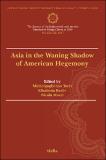Files in this item
Myanmar 2017: The Rohingya crisis between radicalisation and ethnic cleansing
Item metadata
| dc.contributor.author | Fumagalli, Matteo | |
| dc.date.accessioned | 2018-06-28T08:30:05Z | |
| dc.date.available | 2018-06-28T08:30:05Z | |
| dc.date.issued | 2018 | |
| dc.identifier.citation | Fumagalli , M 2018 , ' Myanmar 2017: The Rohingya crisis between radicalisation and ethnic cleansing ' , Asia Maior , vol. XXVIII , pp. 227-243 . | en |
| dc.identifier.issn | 2385-2526 | |
| dc.identifier.other | PURE: 253159802 | |
| dc.identifier.other | PURE UUID: cb9f700d-0034-43be-a7ae-d40651e0d56c | |
| dc.identifier.other | ORCID: /0000-0002-1451-2088/work/46152092 | |
| dc.identifier.uri | https://hdl.handle.net/10023/14679 | |
| dc.description.abstract | 2017 was Myanmar’s annus horribilis. This essay revisits the 2017 Rohingya crisis and discusses its immediate triggers and background causes. It contends that the latest outbreak of violence should not be seen as a one-off occurrence, but rather be understood as part of a long history of anti-Rohingya state and community-led violence, which has intensified in recent years, especially since 2012. What emerged, in fact, was a shift in organisation and tactics on the side of some radicalised segments of the Rohingya community as well as the violent impact of the rampant rise in Buddhist nationalism. The crisis sparked an international outcry, but was met with callousness and denial inside the country, where anti-Rohingya sentiments are widespread and the military operations enjoy wide popular support. The Rohingyas are facing an uncertain future and problematic prospects of return. Among the fallouts of the crisis was the abrupt fall from grace of Myanmar’s de facto leader Aung San Suu Kyi. Showing a total lack of empathy over the human tragedy and, through her silence, condoning anti-Rohingya sentiments and violence, the state counsellor tarnished her international reputation. More than seven years after an unexpected political liberalisation Myanmar’s progress has at best stalled or, quite possibly, shown its true colours: a non-transition in disguise. The Tatmadaw remains firmly in control. | |
| dc.language.iso | eng | |
| dc.relation.ispartof | Asia Maior | en |
| dc.rights | Copyright © 2018 - Viella s.r.l. & Associazione Asia Maior. This work has been made available online in accordance with the publisher’s policies. This is the final published version of the work, which was originally published at https://www.viella.it/rivista/9788833130446 | en |
| dc.subject | Myanmar | en |
| dc.subject | Burma | en |
| dc.subject | Rohingya | en |
| dc.subject | Asia | en |
| dc.subject | Bangladesh | en |
| dc.subject | Genocide | en |
| dc.subject | Ethnic cleansing | en |
| dc.subject | Terrorism | en |
| dc.subject | Radicalisation | en |
| dc.subject | Aung San Suu Kyi | en |
| dc.subject | Rakhine | en |
| dc.subject | Arakan Rohingya Salvation Army | en |
| dc.subject | JZ International relations | en |
| dc.subject | JQ Political institutions Asia | en |
| dc.subject | T-NDAS | en |
| dc.subject | SDG 16 - Peace, Justice and Strong Institutions | en |
| dc.subject.lcc | JZ | en |
| dc.subject.lcc | JQ | en |
| dc.title | Myanmar 2017: The Rohingya crisis between radicalisation and ethnic cleansing | en |
| dc.type | Journal article | en |
| dc.description.version | Publisher PDF | en |
| dc.contributor.institution | University of St Andrews. School of International Relations | en |
| dc.description.status | Peer reviewed | en |
| dc.date.embargoedUntil | 2018-06-27 | |
| dc.identifier.url | https://www.viella.it/rivista/9788833130446 | en |
This item appears in the following Collection(s)
Items in the St Andrews Research Repository are protected by copyright, with all rights reserved, unless otherwise indicated.

